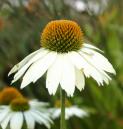Viburnum Prunifolium. U. S. (Br.)
Viburnum Prunifolium. Viburn. Prun. [Black Haw]
Related entry: Viburnum opulus
"The dried bark of Viburnum prunifolium Linné or of Viburnum Lentago Linné (Fam. Caprifoliaceae), without the presence or admixture of more than 5 per cent. of wood or other foreign matter" U. S. "Black Haw is the dried bark of Viburnum prunifolium, Linn." Br.
Virburnum, Br.; Stagbush, Sheep-berry.
Viburnum prunifolium is a tall, very handsome shrub, which is quite common in the Middle and Southern United States, east of the Mississippi, flowering in May and ripening in the early autumn its ovoid or oblong blackish fruit. It is specifically characterized by its acuminate, glabrous winter buds, by its acuminate, sharply serrulate, ovate leaves on long, slender, sometimes broadened and wavy margined petioles. Its sessile cymes are 2 to 5 inches broad and bear oval bluish-black drupes.
Viburnum Lentago L., Sheep Berry. Sweet Viburnum, resembles the previous species, but has the winter buds smaller, less acute and often reddish pubescent, and its leaves stouter petioled and not acuminate at the apex. Its geographical limit overlaps that of V. prunifolium, but extends much further westward and northward, even to Manitoba. The bark of V. dentatum L., or Arrow wood, is said to be sometimes substituted for the official drug.
Properties.—The bark is officially described as "in irregular, transversely curved or quilled pieces, from 1.5 to 6 cm. in length, and from 0.5 to 1.5 mm. in thickness; outer surface grayish-brown, or, where the outer cork has scaled off, brownish-red, longitudinally wrinkled; inner surface reddish-brown, longitudinally striated; fracture short but uneven, showing in bark which is young or of medium thickness, a dark brown cork, a brownish-red outer cortex, and a whitish inner cortex in which are numerous light yellow groups of sclerenchymatous tissues; odor slight; taste distinctly bitter and somewhat astringent. The powder is dark brown; under the microscope it exhibits numerous large stone cells, which are often elongated, thick-walled and strongly lignified; bast-fibers few, crystals of calcium oxalate from 0.015 to 0.035 mm. in diameter, occurring mostly in rosette aggregates, occasionally in crystal fibers; monoclinic prisms of calcium oxalate few." U. S.
"In quills or curved pieces, one to four millimetres thick; dull brown or reddish-brown. Outer surface longitudinally wrinkled or, in older bark, with shallow fissures and scaly; inner surface longitudinally striated, reddish-brown. Fracture granular. In transverse section, a dark brown outer portion and a whitish or reddish bast with numerous groups of sclerenchymatous cells. Slight odor; taste astringent and bitter." Br.
The morphology of viburnum prunifolium is well illustrated by Holm in M. R., xxii, p. 35. Illustrations of the bark of the several species of viburnum are given in Kraemer's "Scientific and Applied Pharmacognosy"; also see P. J., 1903, lxx, p. 197. Lloyd states that the bark of all native species of viburnum are collected by root diggers and sold under the name of black haw. (Ph. Rev., xxiii, p. 333.) The bark of the root is preferred to that of the stem and the official definition formerly limited the drug to the root bark. Farwell reported the substitution of the genuine drug by the bark of some other species of viburnum than those specified by the Pharmacopoeia. The bark is much darker than the official bark and consisted largely of stem bark. (M. R., xvii, p. 35.)
Herman van Alien found the following constituents in viburnum: (1) a, brown resinous body, of a very bitter taste, from which it was found impossible to separate the sugar; (2) a greenish-yellow resin or neutral principle of a bitter taste, slightly soluble in water, freely so in alcohol, called by Kramer viburnin; (3) valeric acid; (4) a tannic acid giving a greenish-black color with ferric salts; (5) oxalic acid; (6) citric acid; (7) malic acid; (8) sulphates; (9) calcium, magnesium, potassium, and iron chlorides. (A. J. P., 1880, 443.) As the result of elaborate investigation, T. Shennan (Royal Coll. Phys. Lab. Rep., Edinburgh, vi, 1897) concludes that the Viburnum, prunifolium contains viburnic—i.e., valeric—acid, and a nonvolatile alkaloid which, however, he failed to obtain in a pure condition.
Viburnum has been used quite largely in the treatment of dysmenorrhea, after-pains, and other uterine disorders. Pilcher (A. I. M., Jan., 1917), however, has shown that in the doses ordinarily employed it has no effect of any kind on the uterine muscle.
R. L. Payne, Jr., has found that when given in toxic amount to the lower animals viburnum produces muscular weakness, ending in complete paralysis. with loss of reflex action, which he believes to be due to an influence upon the motor side of the spinal cord. In warm blooded animals there is also marked lowering of the arterial pressure, believed by Payne to be the result of a direct action of the drug upon the heart. Experiments of Payne have in a measure been confirmed by those of T. Shennan, but as the latter took six drachms of the fluidextract within thirty minutes, with no demonstrable effect except a doubtful decrease of the rate and force of the pulse, it is plain that the drug is very feeble.
The solid extract (dose, from three to ten grains (0.2-0.65 Gm.)) does not represent the drug completely, owing to loss of volatile acid; so that the fluidextract should be preferred, in doses of from one-half to one fluidrachm (1.8-3.75 mils).
Dose thirty to sixty grains (2.0-3.9 Gm.).
Off. Prep.—Extractum Viburni Prunifolii, U. S.; Fluidextractum Viburni Prunifolii, U. S. (Br.); Elixir Viburni Prunifolii (from Fluidextract), N. F.

